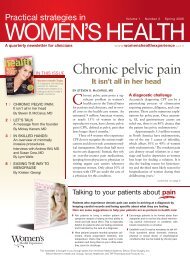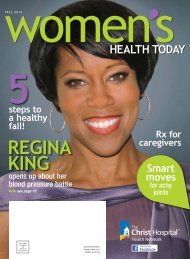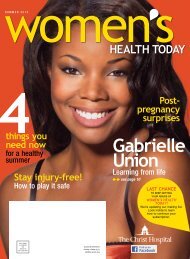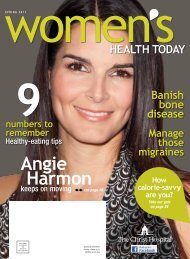continued from page 10“I always needed antibiotics, aspirins or antacids. Iwas tired and had mood swings,” she says. Since goingvegan, however, <strong>Silverstone</strong> reports, “I haven’t takenany of those medicines in more than eight years.”<strong>Silverstone</strong> says being a vegan boosts her energyreserves, helps her sleep better, gives her healthierlookingskin and eyes, and helps her maintain an overallsense of calm. “I went to my doctor for a regularcheckup a few years ago and hadn’t been there forabout seven years. He checked my blood and everythingwas perfect, even better than it was years ago.My body got so healthy.”However, she’s the first to say that playing foodpolice isn’t her favorite role. “I’m not a puritan; I’mjust pure about being a vegan and doing the best I canevery day,” says <strong>Silverstone</strong>.From sugar to squash<strong>Silverstone</strong> credits her healthy bodyand immune system to her plant-baseddiet of whole grains, whole beans andfresh food. Most of the time, all she needsto do is step outside to gather a meal for herself andher husband, musician and fellow vegan <strong>Christ</strong>opherJarecki. “It’s amazing to go into your own backyardand pick vegetables that you planted with your ownlittle hands,” she says. Her organic garden and itscompost area are <strong>Silverstone</strong>’s pride and joy; it’swhere she grows sweet peas, kale, garlic, tomatoesand more.Steamed greens and miso dumpling soup are<strong>Silverstone</strong>’s breakfast staples, and a big salad fullof her fresh-grown vegetables topped with sesametofu dressing is a substantial lunch. “If I eat macrobioticallyevery day, I can lose weight and attain myideal figure. But I don’t like living that rigid lifestyle,so if I’m at a party and they have a cake with icecream, I can’t resist,” says <strong>Silverstone</strong>. “I might have aheadache the next day from the sugar and white flourand feel really low in energy, but food is an art andmade to be enjoyed.”Now-and-then exercise<strong>The</strong> 5-foot-5-inch <strong>Silverstone</strong> keeps her shapewith yoga, hiking with her dogs and riding her bikealong the beach with friends. “Yoga and the dog walkshappen the most regularly, but I can be a bit sporadic.I’m not a puritan; I’m just pureabout being a vegan anddoing the best I can every day.That’s where I’m lucky that my diet and lifestyle areso good, because they compensate for my irregularexercise habits, especially when I’m working,” she says.“But I love doing yoga; it’s really a blissful experience.Jumping on a trampoline is fun, too. And, not manyactresses get giddy over getting dirty fingernails fromgardening like I do.”Best of all, the healthy lifestyle habits <strong>Silverstone</strong>enjoys have helped her achieve clarity and a betteroutlook on life. “I feel spiritually healthy,” she says.“This way of eating has led me on a beautiful path.I’ve learned more about myself and I’m more in touchwith my own body.” WHTVegan or vegetarian?<strong>The</strong>se similar-sounding terms describe people whoadhere to two different types of eating systems.Vegetarians simply don’t eat any meat, fish or fowl.Vegans take it a step further; they don’t eat any animalproducts, eliminating all dairy, eggs and evenhoney from their diets. Vegans need to be sure toget adequate protein and iron from other nutritioussources, like soy products, seeds, whole grains,nuts and green leafy vegetables.© 2008 Kevin Winter/GettyImages12Women’s Health Today
Be emergency-readyAssemble a kit to help yourfamily through a crisisTornadoes, hurricanes, floods, fires, acts ofterrorism and other unexpected emergenciescan force you to evacuate your home ata moment’s notice—or confine you insideit. How would your family fare if you couldn’t get to astore for days? Prepare for a disaster before it strikes byassembling a supply kit to care for your family’s needsin an emergency.© 2008 JupiterimagesDisaster kit contentsYour kit should contain basic items your familywould need to stay safe and comfortable during andafter a disaster. Be sure to include the following:• a three-day supply of water (one gallon per person,per day)• a three-day supply of nonperishable foods and amanual can opener• any special foods or dietary items family membersneed• a flashlight and extra batteries• extra clothing and blankets• matches and cooking equipment• all prescription medicines• medical supplies (diabetes testing and medicationsupplies, catheters, syringes, inhalers, nebulizers)• over-the-counter medicines (pain relievers, anti-diarrhea medicines, antacids, antihistamines, eyedrops)• a cooler with ice or freezer packs for any drugs thatmust be refrigerated• infants’ items like formula, diapers, wipes, bottles,pacifiers• a first-aid kit (sterile gloves, bandages, a cleansingagent or towelettes, antibiotic and burn ointments,eye-wash solution, scissors, tweezers, petroleum jelly,cold packs)• a thermometer• a hearing aid and batteries• wheelchair batteries• eyeglasses and contact lens solution• toilet paper, feminine hygiene supplies• denture needs• oxygen• cash• copies of identification, credit cards and vitalmedical documents, such as insurance and Medicarecards, health records, proxies and prescriptionsAssembling your kitFind an easy-to-carry container, such as a backpackor a plastic bin, in which to pack your kit. Seal all itemsin airtight plastic bags and store your kit in a placewhere it’ll be easy to grab if necessary. Plan for theneeds of any disabled family members and give yourpower company a list of all power-dependent life-support equipment your family uses. Develop a contingencyplan that includes an alternate power source forthe equipment, such as a portable generator or battery.Re-evaluate your family’s needs and update suppliesat least once a year. Check medications for expirationdates every six months and replace when necessary. WHTwww.womenshealthexperience.com 13
















